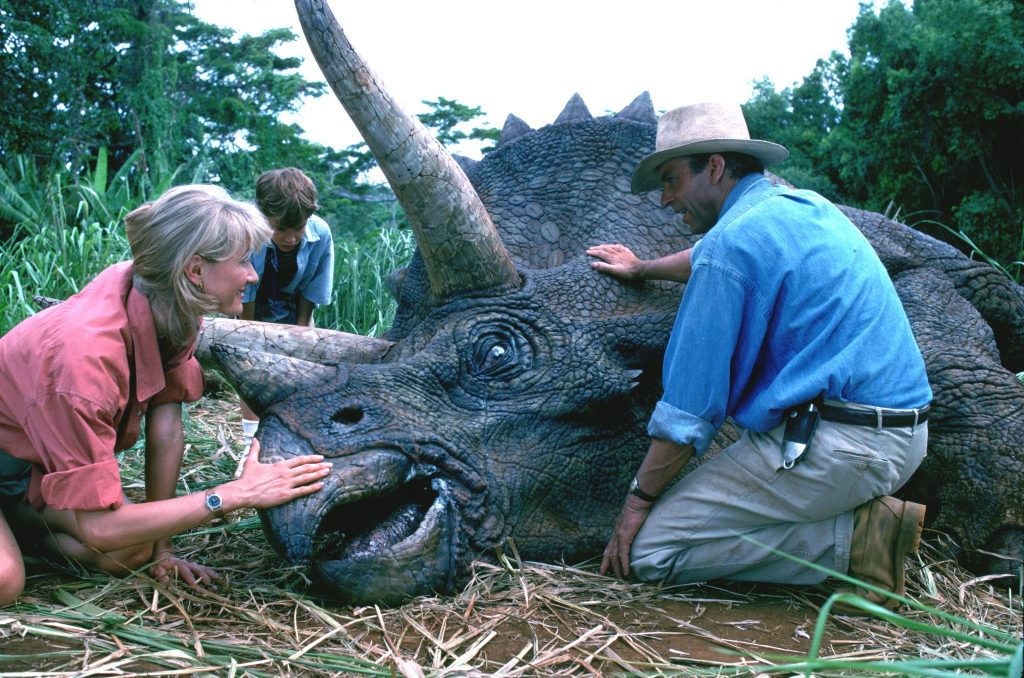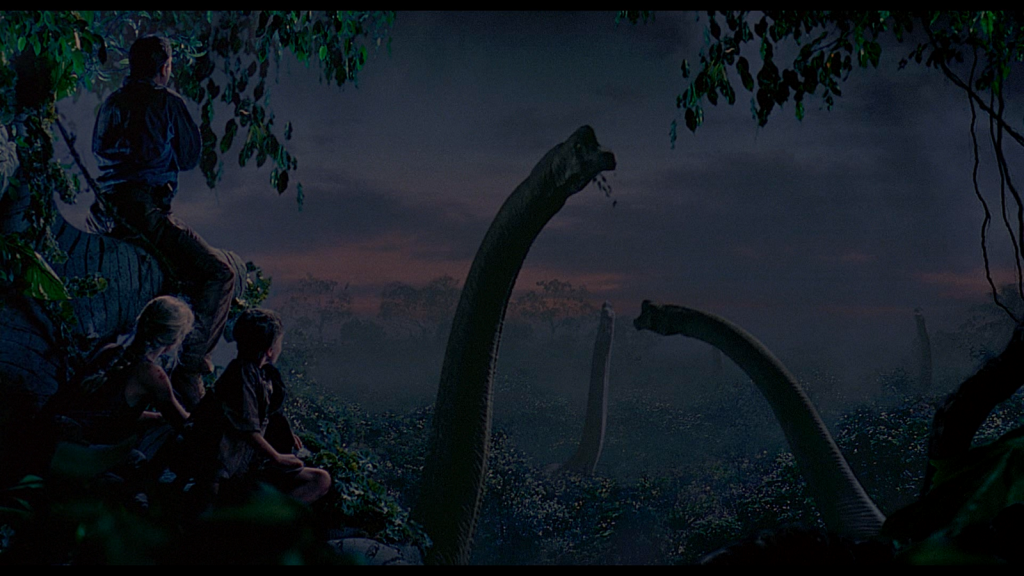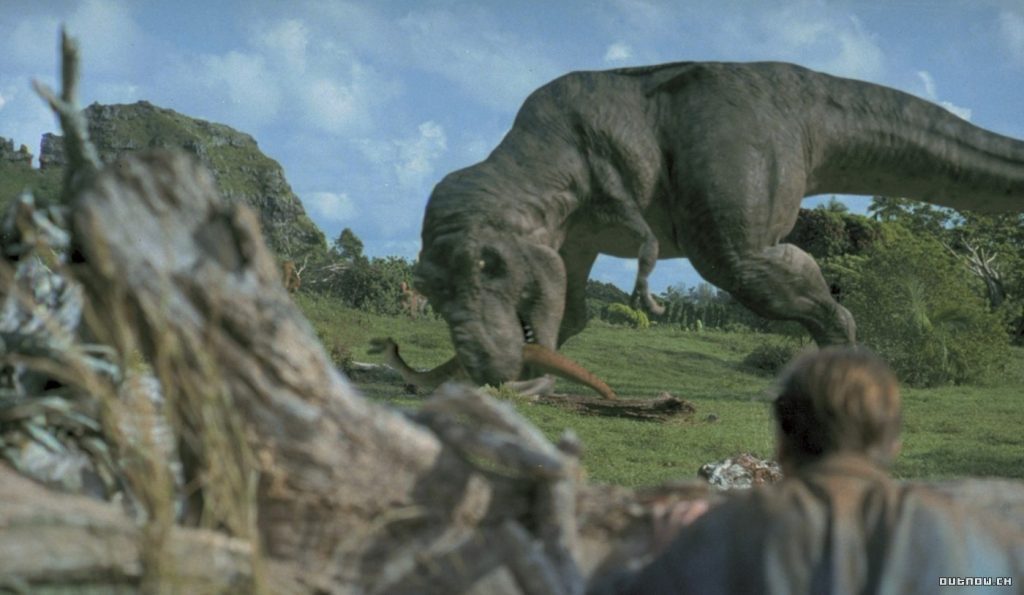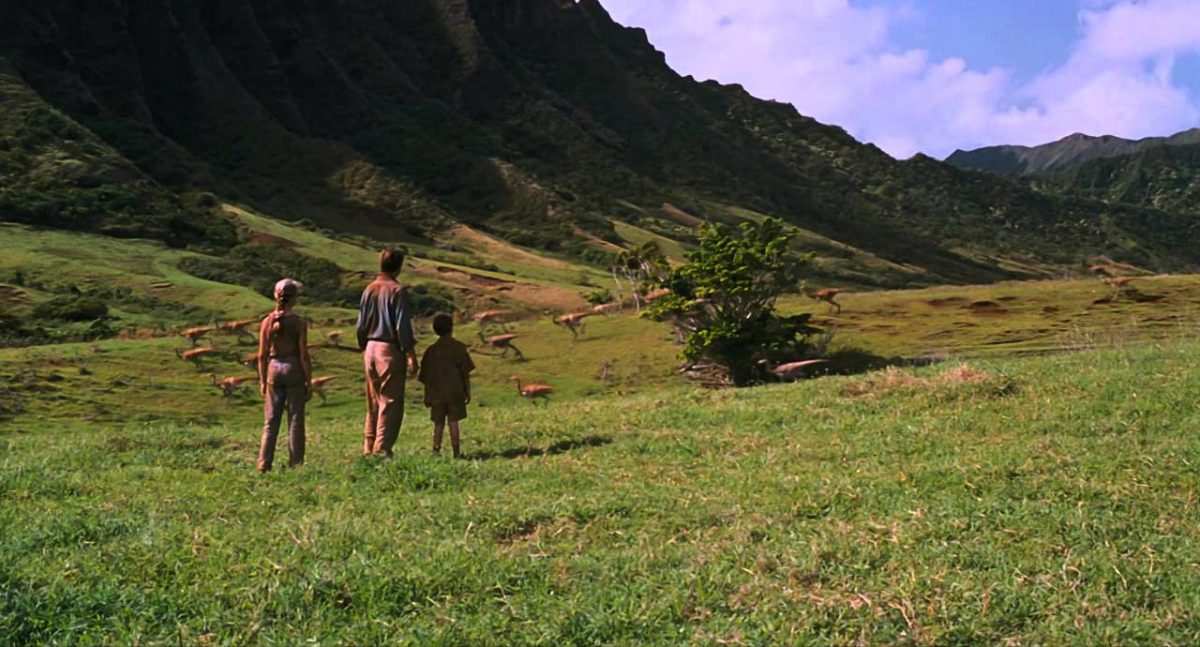(Review originally published in Third Way, May 1993.)
Director – Steven Spielberg – 1993 – US – PG – 127m
*****
A wealthy philanthropist brings dinosaurs to life from preserved fragments of their DNA to populate his island theme park – in cinemas from 16th July 1993 and back out again on Friday, September 1st 2023
“God creates dinosaurs.
God kills dinosaurs.
God creates man.
Man kills God.
Man creates dinosaurs.”
– Dr. Ian Malcolm (Jeff Goldblum), chaos theoretician.
“Dinosaurs kill man.
Women take over the world.”
– Dr. Ellie Sattler (Laura Dern), palaeobotanist.
“Creation is an act of will: next time, it’ll be flawless.”
– John Hammond (Richard Attenborough), creator of Jurassic Park.

Set to become the biggest grossing movie of all time (if it hasn’t already done so by the time you read this), Steven Spielberg’s latest offering concerns rich industrialist John Hammond’s (Richard Attenborough) theme park built around his dream to delight children with wonders come to life. The wonders are dinosaurs, cloned from dino DNA ingested by prehistoric insects subsequently drowned and preserved in amber. For more on this aspect of the story, read co-screenwriter Michael Crichton’s original (and best-selling) novel; Spielberg, who races through small chunks of plot as quickly as he can, isn’t interested in them half as much as he is in dinosaurs. (Nor, in all probability, is 98% of his audience.)
And what dinosaurs the creatures of Jurassic Park are! At the birth of cinema, a story was told of the audience ducking as, on the screen, a train photographed by the Lumière Brothers appeared to race towards them. Of course, we’re all much more sophisticated now – but the first observation about Jurassic Park‘s dinosaurs (wisely excluded from the film’s tacky-looking trailer) is that they are completely and utterly convincing. (All the more so if one sees it on as s magnificent a screen as London’s Empire, Leicester Square, where the film was press screened.) The necks of herbivorous brachiosaurs tower majestically into the sky above the actors, a hungry Tyrannosaurus Rex pursues a fleeing herd of ostrich-like gallimimi across a vast stretch of scrubland, a velociraptor fixes us with its eyes while its sisters prepare to attack us from the side and eat us alive.

As Hammond’s twelve-year-old granddaughter notes, these creatures divide into “meatosaurs and veggiesaurs”. The park itself, controlled by various computer systems including high voltage fences round the pens enclosing the separate species (switched off by the disenchanted software designer so he can commit industrial espionage and pilfer Hammond’s fifteen species of dinosaur embryo for a rival company) is equipped with CD-ROM information screens for visitors while the scientists have used Virtual Reality to aid them in the dinosaur reconstruction process. Any references to chaos theory by mathematician Ian Malcolm (Jeff Goldblum) are purely cosmetic. In effect, the park is set up as a huge interactive game. Once the restraining fences on the meatosaurs are incapacitated, human protagonists become subject to the basic survivalist rules of the horror movie: us or them. Further morality, as often in war, flies out of the window.
Which is curious since Spielberg’s bias towards family, present in little more than outline in Crichton’s novel, pervades the piece. Palaeontologist Alan Grant (Sam Neill) and palaeobotanist Ellie Sattler (Laura Dern) are working colleagues in the book with no sexual relationship, whereas the film transforms them into sexual partners (marital status unspecified) who become surrogate mother and father to the two grandchildren Hammond has brought to the island, along with the various scientific experts required to vet the project by his investors, for the weekend.

By the end of the movie, the ‘father’, ‘mother’ and two children are leaping along the backs of museum dinosaur skeletons as they try and escape pursing velociraptors, the nuclear family climbing above their evolutionary precursors to safety. Hammond himself is changed from the book’s rich philanthropist convinced his creation is infallible (and who is eventually eaten by dinosaurs) to a highly offensive, cuddly rich grandfather figure of Richard Attenborough who ends up not only alive but pathetically backing away from his clearly misjudged scheme.
In the (perceived marketable) Spielbergian universe – or computer game (and Jurassic Park games are already on the market) – families are inevitably warm and friendly and can hold their own against the most monstrous adversity. Sell it may, but the hollowness leaves a nasty aftertaste – sad, when one considers how groundbreaking Jurassic Park is in terms of sheer, visual magic.
Review originally published in Third Way, May 1993.
Trailer:
